Voted the crowd favorite cocktail in 2019, the Margarita is the perfect cocktail. As we’ve learned throughout this history of food series, though, trying to find the true creation story behind a recipe is like trying to find a french fry in a cheese vat: delicious, but scalding. (Does that make sense? Not really, but the same goes for most of history!)
I Have a Feeling We’re Not In Margaritaville Anymore…
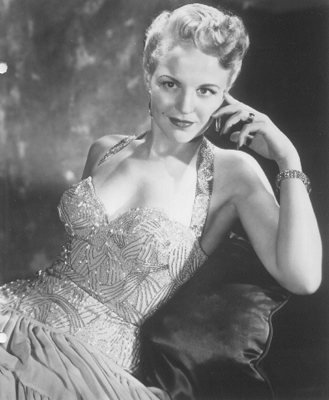
There are about half a dozen well-known origin stories for the Margarita (not to mention the 3 dozen lesser-known myths). And these stories run the gamut in creativity: one takes place in Juarez, Chihuahua in 1942; another at the Acapulco home of a wealthy Dallas socialite in 1948; and yet another involves the singer Peggy (Margaret) Lee.
While these are all lovely stories, there are 3 specific ones that I stumbled across in my research that may give us a glimpse into the Margarita’s true origin. Not only do these stories predate the ones I just mentioned, but they also fit together like a boozy puzzle. This trilogy may hold the secret behind the birth of the Margarita!
The 3 Legends Behind the Margarita

Our story begins in 1862 with the publication of the most famous cocktail recipe book of all time: The Bar-Tender’s Guide, or How to Mix Drinks, or The Bon Vivant’s Companion, by Jerry Thomas. (And, yes, that is all one title!)
Legend #1: Jerry Thomas & The Bar-Tender’s Guide, 1862
Cited as the father of modern bartending, Jerry “The Professor” Thomas was born in 1830 in Sackets Harbor, New York, a town just across the border from Canada. Thomas led a very colorful life, including a short stint as a gold prospector during the California Gold Rush, but his primary pursuit in life was bartending.
In addition to opening several saloons, Thomas became renowned for the artistic flair he gave to his bartending, especially seen in his most notable cocktail, the Blue Blazer. (Jerry’s life is definitely the fodder for another post entirely!)
Thomas was known for constantly having trouble holding onto money, so he was always hard up for cash. This was one of the motivating factors for him to publish The Bar-Tender’s Guide in 1862. He compiled everything he knew about modern bartending (which was a lot!) and included it in his Guide.
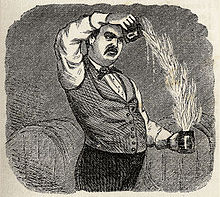
In it, Thomas compiled the most popular cocktail recipes of the time. These cocktails ranged from the Mint Julep (which Thomas famously made for Queen Victoria’s son Edward, the Prince of Wales, on a visit to New York City) to the Hot Milk Punch, a remnant of the American Colonial period.
For the purposes of our story today, we’ll be looking at one of the most popular cocktails in the second edition of Thomas’ book, the Daisy, because it’s believed that the Daisy may have influenced the formation of the Margarita.
The Daisy, circa 1800s
So, when one asks for a Daisy, they’re actually asking for a family of cocktails.
What’s a family of cocktails? Great question!
In the case of the Daisy, it means that most of the ingredients are the same, except for the alcohol; that can be changed. The general flavor profile for each member of the Daisy family, however, is the same: sour, just like a Margarita.
According to cocktail historian David Wondrich, the first reference to the Daisy appears to have been in Henry Llewellyn Williams’ 1886 novel, Gay Life in New York, or Fast Men and Grass Widows where a character requests a version of the Daisy.
The next time the Daisy was referenced was in 1873 when a man named Billy Taylor allegedly walked into a bar in New York City and asked the bartender for “something new.” Taylor apparently shouted out a list of ingredients at the bartender who proceeded to accept the challenge and create a cocktail for Taylor. Apparently satisfied, Taylor exclaimed after a few sips, “By George, that’s a daisy!”
So, what were these ingredients that Taylor shouted at the barkeep? Well, for the answer to that question, we’ll have to turn to “The Professor” and his second edition of the Bar-Tender’s Guide.
What’s In a Daisy?
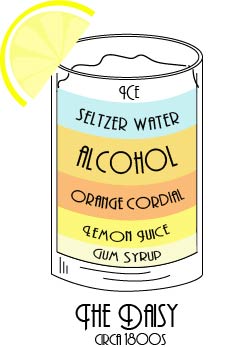
Contact me here!
In 1876, Jerry Thomas printed a second edition to his successful Bar-Tender’s Guide. In this edition, Thomas included the first published recipe for the Daisy. The original recipe lists the ingredients for the Daisy as: gum syrup (simple syrup with gum arabic added to it), orange cordial, lemon juice, and then the alcohol of your choice. (This was either whisky, gin, rum, or brandy. By the late-1800s, though, gin reigned supreme.) All of these ingredients were combined, poured over shaved ice, and then topped with seltzer water.
Does this recipe look familiar? It should because it contains the same basic elements of a traditional Margarita: sweet, sour, and citrus.
If these similarities aren’t enough, the recipe for the New School Daisy seems to bridge the already small gap between the Daisy and the Margarita.
The New School Daisy, circa 1910
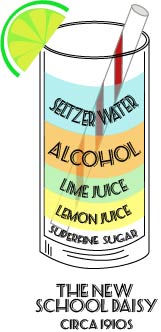
Contact me here!
By 1910, the New School Daisy appeared in the bartender’s arsenal of cocktails. This version of the Daisy, though, made some pretty significant changes that further allude to its possible ancestry to the Margarita.
For starters, the New School Daisy omitted the orange cordial and replaced it with lime juice. The recipe also called for grenadine and superfine sugar in place of the gum syrup. The New School Daisy was still served with seltzer water over ice.
These changes to the Daisy are notable as they appear to possibly be a “missing link” between the Daisy and the eventual Margarita.
The Daisy would once again be changed, but this change would have to wait until after Prohibition.
The Daisy During Prohibition, 1920-1933
During Prohibition, those who could afford to travel sought out a little liquid refreshment in Mexico. Besides beer, the most convenient and inexpensive alcohol in Mexico was tequila.

When travelers (or bootleggers) returned to the United States, they often smuggled bottles of tequila in with them. As a result, bartenders began incorporating tequila into their existing, and some new, cocktail recipes.
Throughout the 1920s and 1930s, the Daisy, whether the traditional version or the New School version, remained a popular cocktail at speakeasies. Prohibition in America was lifted in 1933 and it was around that time that the Tequila Daisy debuted to a thirsty public.
So, just as a refresher (all puns intended!), the recipe for the Tequila Daisy at this point included: lime juice, lemon juice, superfine sugar, seltzer water, and tequila (the grenadine had been more or less omitted by this point).
Now, I don’t know about you, but, to me, this is basically a Margarita.
I feel like now is a good time to point out that the Spanish form of “daisy” is margarita, but I’ll let you do what you want with that little nugget of information.
Legend #2: Café Royal Cocktail Book & the Picador, 1937

In 1937, another landmark cocktail recipe book was published, the Café Royal Cocktail Book: Coronation Edition. This book was published by President of the United Kingdom Bartender’s Guild, William J. Tarling.
In the introduction to Café Royal, Tarling notes that of the thousands of recipes that were in circulation by bartenders in the 1930s, he selected the most popular of the time.
Tarling also references good ol’ Jerry Thomas, noting that the cocktail “…was brought to England in 1895 by the famous Jerry Thomas, who visited London, Southampton, and Liverpool exhibiting his art with the aid of a solid silver set of bar utensils valued at £1,000.”
The Professor strikes again!
By 1895, the published recipe for the Daisy would have been around for over 20 years. As Jerry Thomas is noted for having visited England in 1895, he no doubt would have been mixing up drinks from his repertoire, and the Daisy may have been one of them.
With the emergence of tequila as the new alcohol of choice, and the popularity of the New School Daisy some 10-20 years before, it’s very possible that these two instances are what led to the creation of our next cocktail, the Picador.
The Picador, 1937
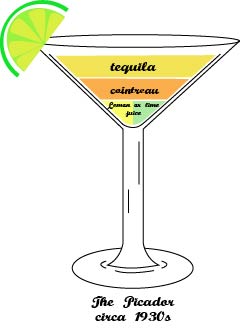
Contact me here!
The recipe for the Picador appears to have first been published in the Café Royal Cocktail Book.
Side note: “picador” is a term used in Spain to reference the person in a Spanish bullfight who jabs the bull with a lance…yum yum.
The recipe for the Picador looks oddly familiar to that of the New School Daisy: lime or lemon juice, cointreau (an orange-flavored liqueur), and tequila.

In the Café Royal, there are no recipes for a Margarita or a Tequila Daisy (only a Whisky Daisy and a Gin Daisy). There is, however, a recipe that is simply called “Tequila” that closely resembles the Tequila Daisy and, in turn, the Margarita. It includes lime juice, lemon juice, grenadine, and tequila.

Either of these cocktails could be the predecessor for the Margarita, though the Picador seems more likely since the ingredients are basically the same as a Margarita.
The year after the publication of the Café Royal Cocktail Book, however, the history of the Margarita takes an unexpected turn.
Legend #3: Carlos “Danny” Herrera & Marjorie King, 1938
And now we get to the most often cited origin story of the Margarita.
We’re going back to 1938, in Rancho La Gloria, near Tijuana in Baja California, Mexico.

Carlos “Danny” Herrera lived with his wife Lucia 20 km from Tijuana in Rosarito. Originally the couple lived in a small house with a dirt floor near Rosarito Beach (somewhere near here), however, Danny realized he could make a decent living by opening up their home to weary tourists and travelers looking for a meal, a drink, or a room.
He built a large, ranch-style house complete with a pool, dining area, and bar. Throughout the years, many celebrities stayed at their home, including Walt Disney, and, of course, Marjorie King.
In a Little Café Just the Other Side of the Border…

On a warm evening, movie actress and Ziegfeld Follies dancer, Marjorie King, wanted to unwind a little. The tall, beautiful brunette stopped at the Herrera’s hotel which she frequented on her trips to Ensenada. Marjorie asked Danny to make her a drink, but with one caveat: it had to be made with tequila since she was allergic to other spirits. No problem, he replied.
Herrera mixed together a drink containing 3 parts tequila, 2 parts Cointreau, and 1 part fresh lemon juice. Adding shaved ice to the mixture, Herrera shook it up, and poured it into a glass rimmed with lemon juice and salt. I call it the margarita, he said. It’s alleged that he called it the margarita because that was the closest Spanish equivalent to Marjorie.
And the rest is history.
Conclusion
By the time our story takes us to Carlos “Danny” Herrera’s inn in the late 1930s, we have learned that the combination of lime juice, sweetener, and tequila was not as revolutionary as we may have initially hoped.
While Jerry “the Professor” Thomas may not have invented the Daisy, the Bar-Tender’s Guide is one of the earliest recorded instances of a possible ancestor to the Margarita.
As the recipe for the Daisy evolved throughout the years (spawning into the New School Daisy and, eventually, the Tequila Daisy), so did the preference for certain types of alcohol. While gin and whisky reigned supreme from the late 19th century through the early 20th century, tequila became a crowd favorite throughout the 1930s.
Because of the popularity of both the Daisy and tequila, many new tequila cocktails were created, including the Picador. There were, of course, other tequila cocktails that called for lime juice and sweetener that were popular throughout the 1920s and 1930s, but none were as popular as the Picador.
Also, considering that Picador is a Spanish name and Margarita is Spanish for daisy (i.e. the Daisy), there may be more parallels than we are led to believe.
All of this to say that I believe that it was possible a combination of these 3 stories that led to the formation of the recipe we know of today as the Margarita by Carlos “Danny” Herrera. Whatever the entire story is will most likely remain a mystery, but thankfully we still have the Margarita to enjoy.
Fauxgarita Mocktail Recipe
The margarita is, without a doubt, one of my top 3 favorite cocktails.
(I might be biased, though, since I’m not sure if my love for the margarita stems from growing up in the Southwest, or if it’s actually true love for the flavors but I digress.)
As I explained in my History of the Daiquiri post, I hate the thought of consuming artificial sweeteners or artificial colorings like Red40 or Blue52 (or whatever), so I avoid them as much as possible. This means that my fauxgarita has only the freshest ingredients that will make you feel like you’re sitting on the soft white sands of your own private island. 🙂
What’s a “Mocktail”?
In case you haven’t heard of the mocktail, they’re a trendy non-alcoholic alternative for those who are “dry” or just don’t feel like getting too lit. Mocktails have the same level of skill and complex flavor pairing as typical cocktails, but just without the alcohol! (Granted, you can always order a virgin drink when you’re out, but who are we kidding?! Asking for a mocktail sounds way better and more sophisticated than having to order a virgin “fill-in-the-blank.”)
Wanna Watch How to Make a Fauxgarita?!
Be sure to watch my video where I give you step-by-step instructions on how to create my Fauxgarita!
(If the thought of a delicious Fauxgarita alone doesn’t entice you enough, there are also lots of silly bloopers involving a particular group of oranges for your giggling pleasure. :P)


The Fauxgarita: a Gluten-Free, Dairy-Free, Paleo Margarita Mocktail Recipe
- Prep Time: 1 minute
- Cook Time: 3 minutes
- Total Time: 4 minutes
- Yield: 1 fauxgarita 1x
- Category: Cocktail, Mixed drink
- Method: Shaken
Description
This Fauxgarita mocktail recipe is super simple which means that you’ll have more time to chill out and enjoy it! This is best enjoyed on a hot, lazy summer day, but it’s also a great cure for the winter blues!
Ingredients
- 2 ½ medium-sized organic oranges, juiced
- ½ organic lime, juiced
- ½ organic lemon, juiced
- 1 tsp. Demerara sugar simple syrup
- Salt for rim
- Topo Chico (optional)
Instructions
- Put a few ice cubes into a mason jar with a lid.
- Pour your orange, lime, and lemon juices into your jar.
- Add the simple syrup, put the lid on your mason jar, and gently shake to combine.
- Rim your margarita glass with salt and strain your Fauxgarita into a fun cocktail glass!
- Enjoy feeling wonderful and full of vitamin C! 🙂
Notes
*If the citrus fruits are sweet enough for you, then skip the simple syrup.
*If you have problems with acid, half all of the citrus quantities and substitute with more Topo Chico.
Keywords: fauxgarita, mocktail, margarita, margarita mocktail, orange juice, lemon juice, lime juice, Topo Chico, cocktail, faux cocktail, cocktail recipe, mixed drink, mixed drink recipe, gluten-free, dairy-free, paleo, paleo cocktail

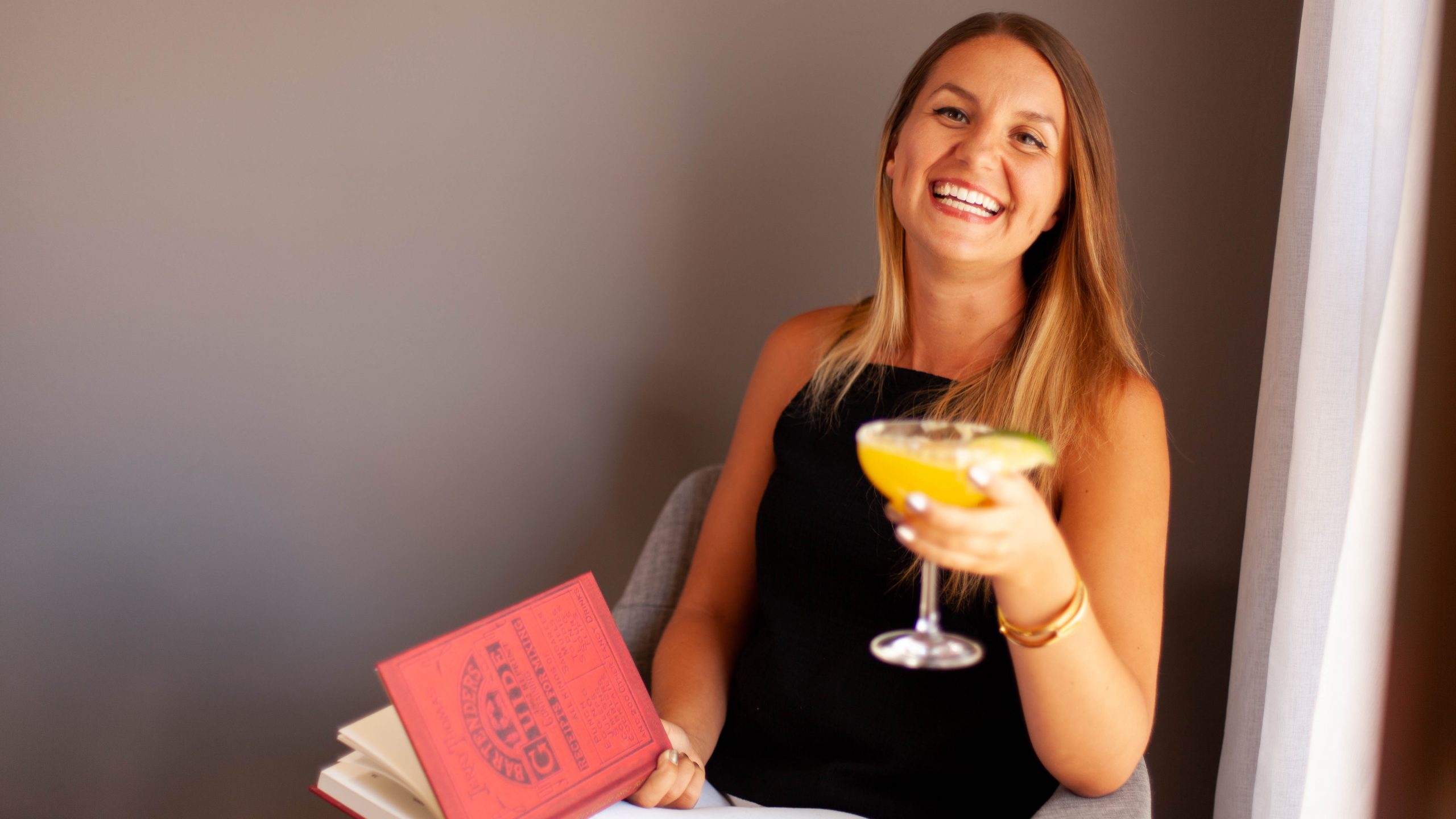
Leave a Reply